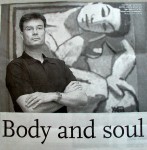Body and Soul
March 2002, South China Morning Post
By Robin Lyman
There was never any doubt that spirituality would feature strongly in painter Wayne Forte’s art. Born in Manila to a Filipino mother and an Irish father, he received a Catholic education in California and some of his earliest memories are of masses in the old Spanish missions.
“My first experience of really looking at art was in the church and I always wanted to do art for the church. Although it’s another part of what I do, I never really wanted to do anything but paint,” Forte, 53, recalls.
As a reminder that his faith is inseparable from his art, some of Forte’s etchings are owned by the Vatican. One of the paintings on display at his one-man show at the 10 Chancery Lane Gallery is broken up by a verse from the Old Testament and another depicts Joseph at the Nativity holding a lantern.
But beneath the apparent religious overtones, Forte insists the theme of this exhibition is the human body, and the sense of spirituality he says forms the core of his art is expressed here in more sensuous terms. Most of the works on display showcase strangely contorted nudes, which have become Forte’s signature style. “Initially I painted landscapes,” he says, “and then in about 1985 I thought, It’s time to tackle the figure seriously.’ That’s when this style of work developed. I still do landscapes and still-life and work with biblical themes, but I think I’m probably considered more of a figurative painter now.”
Although Forte always works from life, many of his subjects are seen assuming poses beyond the reach of even the most flexible models. Freed from the constraints of the physical, his subjects are nevertheless almost painfully constricted in terms of space, often being forced into tiny boxes. “There are thousands of ways to tackle the figure and I started out pretty methodically,” he says. “I knew that I wanted the figure to have power and I struck on the idea of squeezing it into a space so there’s a reservoir of energy. I also wanted the figure to have a relationship to the edge of the format, so the illusionistic space becomes an actual one. These are poses people cannot actually get into, but they are accommodated gradually throughout the drawing, into the box. They grow organically into that space.”
It is an idiosyncratic view of the human form, but Forte’s influences are apparent in the style. As well as the religious art of the mission churches and Mexican revolution paintings of Diego Rivera, he cites Matisse, Braque and Picasso as having had a decisive effect. “I started using the written word the way a cubist would to break up a space. Braque or Picasso would break up a space with lines – I would do the same with letters and text about what I was thinking at that time. Often what I’m really thinking about is my relationship to the model and what that form is suggesting to me,” he explains.
A preference for rough texture and uneven surfaces for his paintings reflects both Forte’s desire that they should be experienced close up and at a distance, and the fact he works quickly and prolifically. All the paintings on display here were produced in a burst of activity last year.
“I do work fast. I’m interested in paint doing what only paint can do, which is squish and drip and all those physical things. I want the person to experience them in that way from up close,” he says. “Then, when they step back, the illusion kicks in. I’m much more interested in that than spending hours on every detail. We have photographs for that.”
Another distinctive element of his art is the use of a limited palette to create an extensive array of shades and tones, another area in which the influence of the cubists is apparent. “I think it’s much better to use fewer colours but to use them to maximum advantage – to stretch them and force them to create as many secondary colours as possible. The most colourful paintings are three colours plus black and white, and a lot of them are only one plus black and white,” he says. “I do ladle in interference colours, but I don’t use them to model the form. Every now and then there’s a splash of blue, which I then cover up, but some things will show through at the end, almost like accidental colours.”

